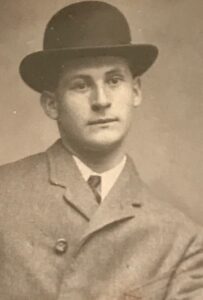
This week we had some cause for a small celebration. For the past several months I’ve been focused on finishing the manuscript for my latest book, A Time for Sacrifice – Emma’s War, and writing a magazine article based on the book. The manuscript is done, and the May 18 Boston Globe Sunday Magazine featured my article as its cover story, Eight Sons at War – The Untold Story of a Melrose Family’s WWII Sacrifice.
I suppose to be historically accurate I should have raised a glass of a cheap red jug wine to celebrate the Emma’s War. That’s because the book is about a French-speaking Canadian woman who emigrated to the United States at the end of the 19th century, raised a family of 15 children during the Great Depression, and sent nine sons to battle in WWII. Her husband Charles (shown above) – my grandfather and the only wine drinker in the family – quaffed a single glass of cheap red wine with dinner every evening. With 15 children running around, perhaps he should have killed the bottle.
- Consider, however, that his options were limited because Prohibition was in effect from 1920 through 1933, and the only wine legally available was that made at home. Entrepreneurship triumphed, however, because one company sold “bricks” of grapes with the warning: “After dissolving the brick in a gallon of water, do not place the liquid in a jug away in the cupboard for twenty days because then it would turn into wine.”
- Even after the end of Prohibition wine quality didn’t improve for several decades because the U.S. wine industry had been decimated.
- Fortunately, we now live in an era of amazing wine quality and choice, so a red jug wine seemed like a bridge too far for the sake of historical accuracy. Charles would have approved.
The logical choice for a celebratory wine is obviously Champagne. Sure, there’s a wide range of sparkling wines available, but Champagne is identified with celebrations and good times, and for good reason. So, which one to pick?
- We’ll save the Prestige Cuvée (a champagne house’s most prestigious, and expensive, offering) for when the book is ultimately released (sometime in 2026). So, we searched the Wine Concepts cellar for a good non-vintage bottle.
- Like most Americans, we prefer a Brut or Extra Brut champagne. From least to most sweet, the champagne sweetness levels are Brut Nature, Extra Brut, Brut, Extra-Sec, Sec, Demi-Sec and Doux.
Our featured wine is the Laurent-Perrier Ultra Brut (about $80 retail). This is a bone-dry, non-vintage Champagne (it’s a blend of about fifteen vintages) made from roughly equal portions of Pinot Noir and Chardonnay. It’s pale yellow with an effusive stream of delicate bubbles. It features aromas of citrus and white flowers, and the palate has a vibrant acidity with notes of citrus and minerality.
- Ultra Brut makes a great aperitif and pairs nicely with most foods. But is also goes nicely with a good read!
Cheers!
